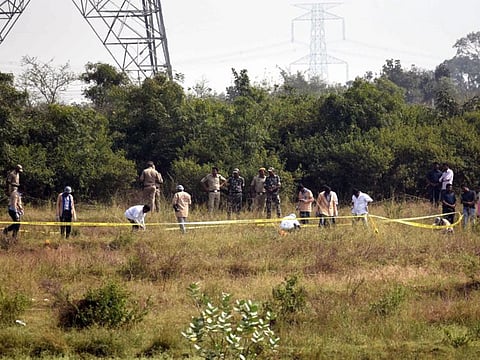Why the lure of instant justice is dangerous for India
Four suspects in rape-murder case in Hyderabad were recently killed in a police encounter

The gruesome and horrifying events of that fateful night of December 7, 2019, in Hyderabad have been replayed on Indian TV so many times that a numbing and deadening of senses has set in: Screaming headlines, sensationalism, and meaningless debates muffle the tragedy, the apathy and total incompetence of the police authorities.
The facts get obscured and the story morphs into a case of ‘triumph of instant justice’ and less on the victim, the lead up to the crime scene, the police inaction (the parents of the deceased had to plead for three days before the case was registered), the long history of extrajudicial killings in Telugu-speaking states, and above all the strange case of Cyberabad Police Commissioner V.C. Sajjanar, in whose jurisdiction this crime took place. Sajjanar deserves a special study and a nomenclature (if the victim has acquired a sobriquet, so does the Commissioner).
Some inconsequential parallels have been drawn between what happened some seven years ago in the gang rape victim of 2012 — and the current Hyderabad rape case: the professional connect of both victims being in the medical profession, one a veterinarian and the other a paramedic, both having died tragically and brutally fighting their oppressors to the last, the attackers being lumpen elements not far removed from the social class of the victims and the perpetrators of the crime being from the public transport industry.
The lure of instant justice is perfidious. It’s a throwback to ancient times and a makes a complete mockery of modern jurisprudence: A descent into a dystopian worldRavi Menon
To add to these stumbling inanities, the police in India has the gumption to quickly name the victim “Disha” (in Sanskrit it means direction) while the 2012 case was called “Nirbhya” (the fearless).
The irony of using “direction” seems to have been lost on the police authorities, for if instant justice is going to be the “direction” and mantra and guiding principle of the primary agency to enforce the laws of this country then, no one can help India: And what is more terrifying is that the public at large seem happy to have trigger-happy cops patrolling the streets.
The expression “encounter specialists” has taken on an altogether new and added dimension and lustre.
Celebratory messages and distribution of sweets, and the victims’ parents lauding these incompetent police officers, make blaring headlines.
Indeed civil society, in the mistaken belief that as the judiciary has failed, a free hand needs to be given to these gung-ho law officers to step into the breach is misconceived and disastrous.
A retired justice of the Supreme Court of India writing in The Indian Express on the recent happenings bemoans the state of the criminal justice system in the country and quotes Shakespeare “Fair is foul and foul is fair: Hover through the fog and filthy air,” and goes on to quote grim statistics of encounter deaths in recent times …
“In the celebrations and furore following the recent encounter in Telangana, the Uttar Pradesh police announced that in the last two years they have killed 103 criminals and injured 1,859 in 5,178 engagements. Over this period, instead of remaining on bail, as many as 17,745 criminals have voluntarily had their bail cancelled or have surrendered, apparently fearing death in an engagement, echoing the words of a former judge suggesting to an accused that he would be safer in jail. What do encounters achieve other than the death of fellow humans masquerading as instant justice?
“The report of Justice V.K. Agarwal, on the Sarkeguda massacre of June 2012 in Chhattisgarh, is a shocking example of innocents being slaughtered on an extrajudicial assessment of guilt for a crime not even committed.”
His most telling remark is “these examples raise questions not of instant justice, but of instant injustice”.
Also Read: India cops don’t have license to kill
India Today, writing on the Cyberabad Police Commissioner, says, “It’s a tale of two encounters 11 years apart with many similarities — both in December and both featuring V.C. Sajjanar. He was in 2008 the Superintendent of Police and story begins in Warangal. The story began in Warangal on December 10 that year. Swapnika and T. Pranitha ... were riding home on a two-wheeler when three youths on a motorcycle came alongside and threw sulphuric acid on [the girls] ... The incident led to protests across what was then unified Andhra Pradesh.”
And Sajjanar, who headed the probe, arrested three men — only to have them killed three days later on the pretext of a fatal encounter.
The lure of instant justice is perfidious. It’s a throwback to ancient times and a makes a complete mockery of modern jurisprudence: A descent into a dystopian world.
Strange that India should be walking back the theories of distributive justice and ethics propounded by John Rawls, widely considered one of the most important political philosophers of our times: And yet calls itself the world’s largest democracy.
— Ravi Menon is a Dubai-based writer and thinker, working on a series of essays on India and on a public service initiative called India Talks.
Sign up for the Daily Briefing
Get the latest news and updates straight to your inbox



